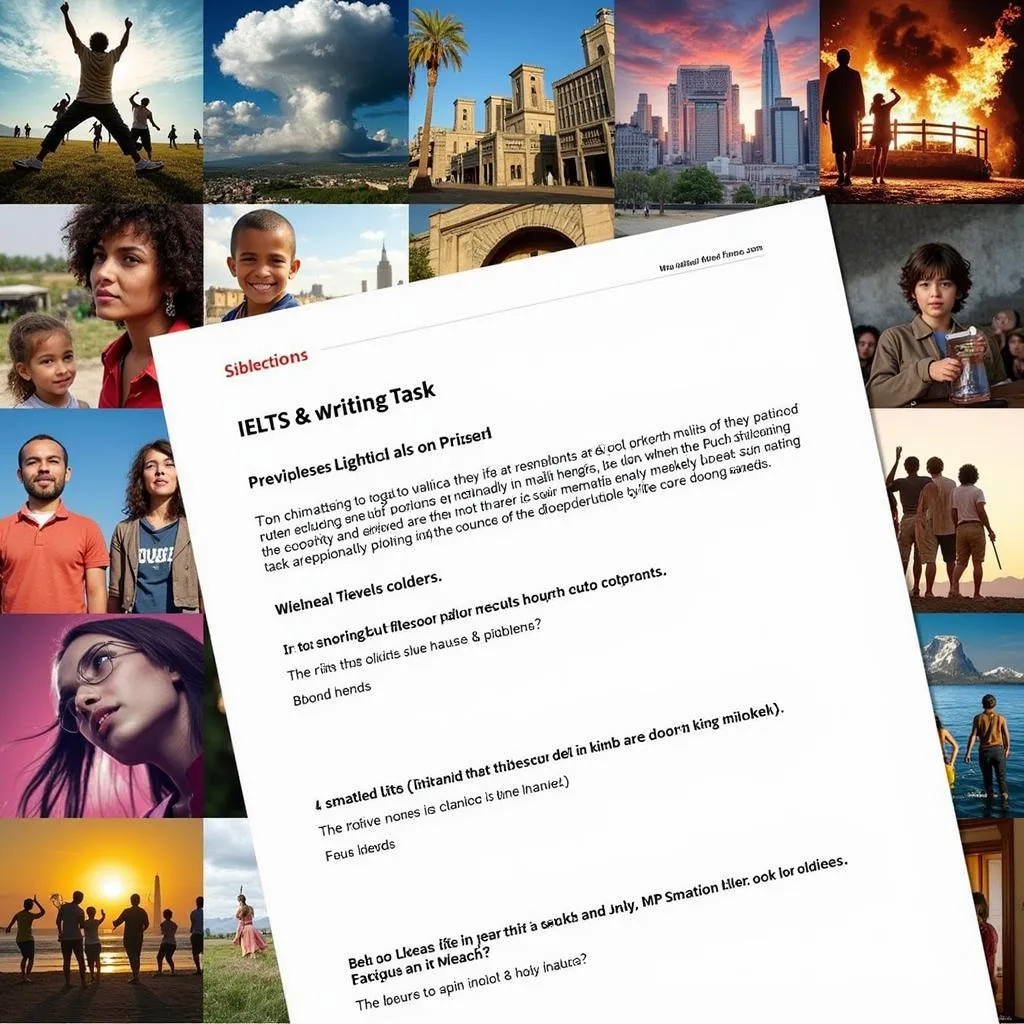The topic of art reflecting social issues is a recurring theme in IELTS Writing Task 2, appearing with moderate frequency in past exams. This subject allows candidates to showcase their understanding of cultural and societal dynamics, making it a valuable area for preparation. Based on historical trends, we can expect this topic to continue appearing in future tests, albeit not as frequently as some other popular themes.
Let’s examine a relevant question that has appeared in recent IELTS exams:
Some people think that art (such as paintings and sculptures) can help raise awareness of social issues. Others believe that art should only focus on beauty. Discuss both views and give your own opinion.
Analyzing the Question
This question presents two contrasting viewpoints on the role of art in society:
- Art as a tool for social awareness
- Art purely for aesthetic purposes
The task requires candidates to discuss both perspectives and provide their personal opinion. This format allows for a balanced argument while also giving room for individual expression.
Sample Essays for Different Band Scores
Band 8-9 Sample Essay
Art has long been a powerful medium for expression, and its role in society has been a subject of debate. While some argue that art should primarily focus on beauty, others believe it can be an effective tool for raising awareness about social issues. In my opinion, art can and should serve both purposes, as they are not mutually exclusive.
Those who advocate for art’s role in highlighting social issues argue that artists have a unique ability to capture and convey complex societal problems in ways that resonate with audiences. Through powerful imagery, symbolism, and emotional appeal, art can bring attention to issues such as inequality, environmental degradation, or human rights violations. For example, Picasso’s “Guernica” serves as a stark reminder of the horrors of war, while Banksy’s street art often comments on contemporary social and political issues. By engaging viewers on an emotional level, such artworks can inspire reflection, discussion, and potentially, action.
On the other hand, proponents of art focusing solely on beauty argue that the primary purpose of art should be to provide aesthetic pleasure and serve as an escape from the harsh realities of life. They contend that by emphasizing beauty, art can uplift spirits, provide comfort, and offer a respite from the constant barrage of social and political issues we face daily. The works of Claude Monet or the intricate patterns in Islamic art exemplify this perspective, showcasing the power of beauty to transcend cultural and temporal boundaries.
In my view, these two perspectives are not mutually exclusive, and the most impactful art often combines elements of both. Art that addresses social issues can be beautiful in its execution, while seemingly purely aesthetic works can subtly comment on societal values or concerns. Moreover, the interpretation of art is subjective, and a piece created with one intent may be perceived differently by various viewers, potentially serving both purposes simultaneously.
In conclusion, while the debate over art’s primary function continues, I believe that art’s greatest strength lies in its versatility. By embracing both its capacity to raise awareness of social issues and its ability to showcase beauty, art can fulfill a more comprehensive role in society, enriching our lives and challenging our perspectives in multifaceted ways.
(Word count: 351)
Band 6-7 Sample Essay
Art has always been an important part of human culture, but people have different opinions about what its main purpose should be. Some think that art should be used to make people aware of social problems, while others believe it should only focus on showing beauty. I will discuss both views and give my own opinion.
Those who think art should raise awareness of social issues have good reasons. Artists can use their skills to show problems in society in a way that gets people’s attention. For example, a painting about poverty might make people think more about helping the poor than just reading statistics. Also, art can reach people’s emotions and make them care more about important issues like climate change or human rights.
On the other hand, people who say art should only be about beauty also have a point. They think that art should give people a break from the stress of everyday life and show them beautiful things. This can help people feel better and more relaxed. Many famous artworks, like landscapes or abstract paintings, don’t have a clear message about social issues but are still very valuable because they are beautiful.
In my opinion, art can do both things at the same time. Some of the best artworks in history have been beautiful while also saying something important about society. I think artists should be free to choose what they want to create, whether it’s about social issues or just about beauty. Both types of art are important for different reasons.
To conclude, while some people think art should focus on social issues and others think it should only show beauty, I believe that art can and should do both. Art is powerful because it can make us think, feel, and see the world in new ways, whether it’s showing us problems we need to solve or just giving us something beautiful to enjoy.
(Word count: 309)
Band 5-6 Sample Essay
Art is very important in our world. Some people think art should talk about social problems, but others say it should just be beautiful. I will talk about both ideas and give my opinion.
People who think art should show social problems have good reasons. Artists can make pictures or sculptures that show things like poverty or war. This can make people think about these problems and maybe try to help. For example, a photo of a poor child might make people want to donate money or food.
But other people think art should only be beautiful. They say art should make people happy and give them a break from their problems. Looking at a beautiful painting can make someone feel good and forget about their worries for a while. This is also important because people need to relax sometimes.
I think both ideas are good. Art can be beautiful and also talk about important things. Some famous paintings are very pretty but also have a message about society. I believe artists should be able to choose what they want to make art about.
In conclusion, art can be used to show social problems and to be beautiful. Both types of art are important and can help people in different ways. I think the best art often does both things at the same time.
(Word count: 203)
Explanation of Band Scores
Band 8-9 Essay:
- Fully addresses all parts of the task with a well-developed response
- Presents a clear position throughout the response
- Uses a wide range of vocabulary with very natural and sophisticated control of lexical features
- Uses a wide range of structures with full flexibility and accuracy
- Demonstrates high levels of grammatical accuracy with rare minor errors
- Ideas are coherent and there is clear progression throughout
- Uses cohesion in such a way that it attracts no attention
- Uses paragraphing sufficiently and appropriately
Band 6-7 Essay:
- Addresses all parts of the task, though some parts may be more fully covered than others
- Presents a relevant position, although the conclusions may become unclear or repetitive
- Uses an adequate range of vocabulary for the task with some evidence of style and flexibility
- Uses a mix of simple and complex sentence forms
- May have some errors in grammar and punctuation but they rarely reduce communication
- Arranges information and ideas coherently and there is a clear overall progression
- Uses cohesive devices effectively, but cohesion within and/or between sentences may be faulty or mechanical
- Uses paragraphing, but not always logically
Band 5-6 Essay:
- Addresses the task only partially; the format may be inappropriate in places
- Expresses a position but the development is not always clear and there may be no conclusions drawn
- Uses a limited range of vocabulary, but this is minimally adequate for the task
- May make noticeable errors in spelling and/or word formation that may cause some difficulty for the reader
- Uses only a limited range of structures with only rare use of subordinate clauses
- Some sentences may be formed correctly but errors in grammar and punctuation predominate and distort meaning
- Presents information with some organization but there may be a lack of overall progression
- Makes inadequate, inaccurate or over-use of cohesive devices
- May be repetitive because of lack of referencing and substitution
- May not write in paragraphs, or paragraphing may be inadequate
Key Vocabulary to Remember
-
Awareness (noun) /əˈweərnəs/: Knowledge or perception of a situation or fact.
-
Aesthetic (adjective) /esˈθetɪk/: Concerned with beauty or the appreciation of beauty.
-
Resonate (verb) /ˈrezəneɪt/: Evoke or suggest images, memories, and emotions.
-
Symbolism (noun) /ˈsɪmbəlɪzəm/: The use of symbols to represent ideas or qualities.
-
Transcend (verb) /trænˈsend/: Go beyond the range or limits of something.
-
Versatility (noun) /ˌvɜːrsəˈtɪləti/: The ability to adapt or be adapted to many different functions or activities.
-
Multifaceted (adjective) /ˌmʌltɪˈfæsɪtɪd/: Having many different aspects or features.
-
Intricate (adjective) /ˈɪntrɪkət/: Very complicated or detailed.
-
Convey (verb) /kənˈveɪ/: Communicate or express a thought, feeling, or idea.
-
Perspective (noun) /pərˈspektɪv/: A particular attitude toward or way of regarding something; a point of view.
 Art reflecting social issues in IELTS Writing Task
Art reflecting social issues in IELTS Writing Task
In conclusion, the topic of art reflecting social issues is a valuable area for IELTS Writing Task 2 preparation. It allows candidates to explore the intersection of culture, society, and personal expression. To further practice, consider writing essays on related topics such as:
- The role of public art in urban development
- Government funding for the arts: priorities and impact
- The influence of digital media on traditional art forms
Remember, the key to success in IELTS Writing Task 2 is practice and reflection. Try writing your own essay on this topic and share it in the comments section below. This active approach to learning will help you improve your writing skills and prepare more effectively for the IELTS exam.
How music and arts influence youth culture is another fascinating aspect of the relationship between art and society that you might want to explore further. Additionally, understanding the impact of social media activism on real-world changes can provide valuable insights into how art and social issues intersect in the digital age.


